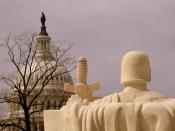Guantánamo has many faces. For some it conjures the "Guantanamera" guajira (peasant woman), sung to the verses of the leader of the Cuban war of independence of 1895, the lawyer and poet Jose MartÃÂ. To others it is the tropical sugar-mill town of some 200,000 inhabitants in the easternmost province of Cuba. To most Americans "Gtmo" only means the Bay and the naval base on it, the oldest outside of the United States, which was occupied by the US during the Spanish-American war of 1898 and subsequently leased by the US from Cuba pursuant to a 1903 lease agreement. One of Cuba's best ports, Gtmo occupies an area of 117.6 square kilometres (larger than Manhattan Island) for which the United States used to pay an annuity of $2,000 (increased to $4,085 in 1934). Cuba, however, does not cash the annuity checks and instead has repeatedly asked the United States since 1959 to dismantle the base and leave, since the lease had been imposed by force, and such arrangements are deemed invalid under modern international law.
For Amnesty International and Human Rights Watch, Guantánamo means the "legal black hole" for 660 internees from 42 nations, some of them Taliban fighters, suspected terrorists and other persons captured in Afghanistan, Pakistan, Bosnia and other countries and flown to Cuba, thousands of miles away, for internment in Camp X (now Camp Delta) nearly two years ago. For the British senior Justice Lord Johan Steyn, Guantanamo entails "a monstrous failure of justice."
Legal Status of the Detainees
As to the legal status of the detainees, the International Committee of the Red Cross observes that essentially they "have been placed beyond the law." But is there such a thing as a "legal black hole"? I submit that there is not. As a corollary to Baruch Spinoza's...



@Guantanamo
This essay provides a good insight into the human rights abuses at the most notorious prison in the world.
A bit more detail about the detainee conditions would have added greater value to this essay.
1 out of 1 people found this comment useful.